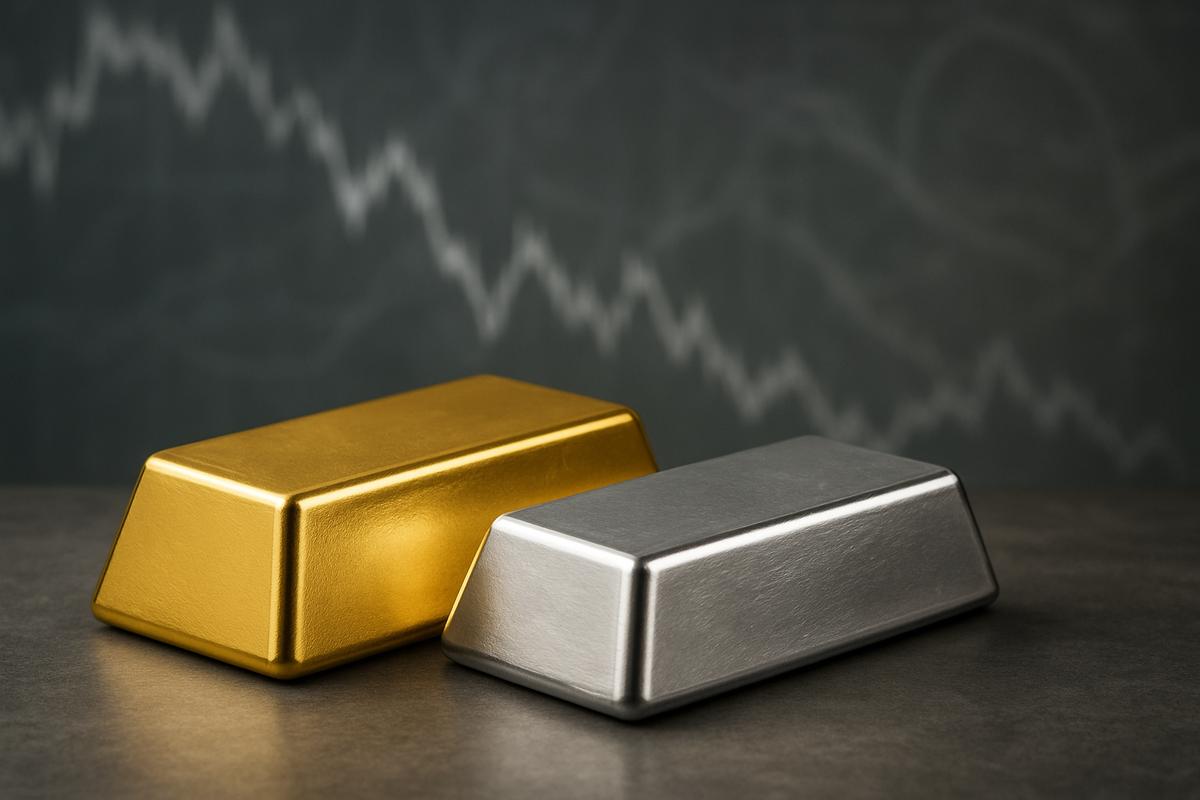
In an era defined by persistent market volatility and a landscape of economic uncertainties, investor sentiment towards gold and silver has surged, positioning these precious metals as crucial anchors in diversified portfolios. As global financial markets grapple with a myriad of challenges, from looming recession fears and geopolitical tensions to shifting monetary policies, investors are increasingly turning to the historical safe havens of gold and silver to preserve capital and mitigate risk. This renewed interest underscores a broader recognition of their intrinsic value and their unique role in shielding wealth during turbulent times.
The current climate of economic unease, characterized by a U.S. government shutdown, declining consumer confidence, and weak economic data, has fueled a significant "flight to safety." Expectations of potential Federal Reserve interest rate cuts further enhance the appeal of non-yielding assets like gold and silver, as lower rates reduce the opportunity cost of holding them. Coupled with a weakening U.S. dollar, which makes these metals more affordable for international buyers, the demand for gold and silver is experiencing a robust resurgence, highlighting their enduring status as reliable stores of value amidst financial instability.
Unpacking the Recent Surge in Precious Metals
The recent performance of gold and silver reflects a strong investor migration towards tangible assets. Gold, in particular, has ascended to multi-year highs, attracting substantial inflows into gold exchange-traded funds (ETFs) globally. This upward trajectory is not merely speculative; it is underpinned by a series of events and economic indicators that have collectively bolstered its appeal. The timeline leading up to this moment includes persistent inflation concerns, exacerbated by supply chain disruptions and elevated energy prices, which have eroded the purchasing power of fiat currencies. Geopolitical flashpoints around the globe have also played a significant role, prompting investors to seek out assets traditionally perceived as hedges against political instability.
Silver has mirrored gold's rally, benefiting from its dual identity as both a precious metal and a vital industrial commodity. Beyond its safe-haven attributes, robust physical demand from burgeoning industrial sectors, particularly solar energy and electronics, has contributed significantly to its price appreciation. Analysts are projecting a supply deficit for silver, further supporting its bullish outlook. Key players in this market include central banks, which have been net buyers of gold, signaling their own strategic diversification away from traditional reserve currencies. Major institutional investors and a growing cohort of retail investors, wary of equity market fluctuations and bond market uncertainties, are also channeling capital into precious metal-backed instruments and physical holdings. Initial market reactions have seen a clear shift in asset allocation strategies, with many financial advisors now recommending a strategic weighting towards gold and silver to enhance portfolio resilience.
Companies Navigating the Precious Metals Boom
The heightened investor interest in gold and silver creates a distinct set of winners and losers within the public market, primarily impacting mining companies, precious metal streamers, and related exchange-traded funds (ETFs). Companies with strong production profiles and healthy balance sheets are poised to capitalize on rising commodity prices.
Winners:
- Gold Mining Companies: Major gold producers like Barrick Gold Corp. (NYSE: GOLD) and Newmont Corporation (NYSE: NEM) are direct beneficiaries. Higher gold prices translate to increased revenues and improved profit margins, assuming their operational costs remain stable. These companies can see their stock prices appreciate significantly as their underlying asset value grows. Exploration and development companies with promising new projects also stand to gain, as higher gold prices make previously uneconomical deposits viable.
- Silver Mining Companies: Similarly, silver miners such as Pan American Silver Corp. (NASDAQ: PAAS) and Wheaton Precious Metals Corp. (NYSE: WPM), a streaming company, benefit from silver's upward trend. Given silver's industrial demand, companies with exposure to both precious and base metals can experience a dual tailwind.
- Precious Metals ETFs: Funds like SPDR Gold Shares (NYSEARCA: GLD) and iShares Silver Trust (NYSEARCA: SLV) are direct vehicles for investors to gain exposure to the price movements of gold and silver without holding the physical metal. These ETFs experience increased inflows, which in turn drives up their asset under management and often their share price.
- Refiners and Dealers: Companies involved in the refining, minting, and dealing of physical gold and silver also see increased business volume as demand for physical bullion rises.
Potential Losers/Those Facing Challenges:
- Companies with High Production Costs: Miners with inefficient operations or those extracting from difficult, high-cost mines might not see the same boost in profitability, as higher operational expenses could eat into the gains from increased metal prices.
- Companies with Significant Debt: While higher revenues can help service debt, companies with substantial leverage might face challenges if metal prices were to unexpectedly reverse course, leaving them vulnerable.
- Companies Heavily Reliant on Fiat Currencies: In a scenario where precious metals are rallying due to inflation or currency devaluation, companies whose business models are entirely tied to the stability and strength of traditional fiat currencies might experience indirect negative effects, such as reduced purchasing power or increased operational costs.
The sustained demand for gold and silver encourages mining companies to ramp up production and explore new reserves, potentially leading to increased capital expenditures but also long-term growth. However, they must also contend with regulatory hurdles, environmental concerns, and fluctuating energy costs, which can impact their bottom line.
Broader Implications and Historical Context
The current surge in investor sentiment towards gold and silver is not an isolated event but rather a significant indicator of broader industry trends and economic anxieties. This "flight to safety" aligns with a historical pattern where precious metals shine during periods of heightened uncertainty, serving as a classic hedge against inflation, currency devaluation, and geopolitical instability. The ongoing concerns about a potential global economic slowdown, coupled with the persistent inflationary pressures, underscore a widespread lack of confidence in traditional financial assets. This trend reinforces the role of gold and silver as essential components for portfolio diversification, offering a counter-cyclical buffer when equity markets falter and bond yields remain suppressed or volatile.
The ripple effects of this increased demand extend beyond the mining sector. Central banks globally have been net purchasers of gold for several years, a trend that accelerated in response to geopolitical realignments and a desire to diversify reserves away from the U.S. dollar. This institutional demand provides a strong fundamental underpinning to the gold market. For silver, its dual role as a monetary metal and an industrial commodity means its price is also influenced by the health of the manufacturing sector, particularly in green technologies. Any regulatory pushes towards renewable energy, such as solar power, or increased adoption of electric vehicles, directly boosts industrial demand for silver, creating a unique synergy that differentiates it from gold. Historically, periods of high inflation (above 5% annually) have seen gold prices increase significantly, averaging 16.2% per year, demonstrating its effectiveness as an inflation hedge. The current environment, with lingering inflationary concerns and aggressive monetary policy shifts, draws clear parallels to past eras where precious metals proved their mettle, solidifying their reputation as reliable stores of value in tumultuous times.
What Comes Next for Gold and Silver
Looking ahead, the trajectory for gold and silver appears robust, though subject to evolving economic and geopolitical dynamics. In the short term, continued market volatility, potential interest rate cuts by the Federal Reserve, and ongoing geopolitical tensions are likely to sustain strong demand for both metals. Gold is expected to maintain its upward momentum, potentially testing new highs, especially if economic data continues to signal a slowdown or if inflation remains stubbornly elevated. Silver, with its industrial tailwinds from the green energy transition, could see even more pronounced gains, particularly if global manufacturing activity picks up, creating a supply squeeze against robust demand.
Long-term possibilities include gold solidifying its role as a core strategic asset for institutional investors and central banks, further diversifying global reserve holdings. For individual investors, gold and silver will likely remain critical components of a diversified portfolio, offering protection against unforeseen economic shocks and currency debasement. Potential strategic pivots for mining companies might involve increasing exploration and development budgets to capitalize on higher prices, while investors might shift allocations to include a higher weighting of precious metals, perhaps within the 5-15% range, depending on individual risk tolerance. Market opportunities may emerge in specialized precious metals funds, royalty and streaming companies, and even in physical bullion markets, as investors seek various avenues for exposure. Conversely, challenges could arise from a sudden reversal in monetary policy, a significant strengthening of the U.S. dollar, or a resolution of geopolitical conflicts, which could temporarily dampen safe-haven demand. Nevertheless, the prevailing economic uncertainties suggest a sustained bullish outlook for these enduring assets.
A Resilient Anchor in Uncertain Seas
In summary, the current investor sentiment towards gold and silver is overwhelmingly positive, driven by a complex interplay of market volatility, economic uncertainties, and geopolitical risks. These precious metals have reaffirmed their historical role as critical safe-haven assets and effective hedges against inflation and currency devaluation. Gold's surge to multi-year highs and silver's robust rally, supported by both investor demand and industrial applications, underscore their enduring value in a world grappling with financial instability. Companies in the mining sector, particularly those with strong production and efficient operations, stand to gain significantly from sustained high prices, while ETFs provide accessible avenues for broader investor participation.
Moving forward, the market will closely watch central bank policies, particularly the Federal Reserve's decisions on interest rates, and the evolution of global economic data. The ongoing demand from central banks for gold, coupled with the increasing industrial applications for silver in green technologies, provides a strong fundamental backdrop for continued strength. Investors should consider the strategic inclusion of gold and silver in their portfolios as a means of diversification and risk mitigation, paying close attention to their low correlation with traditional assets. As economic landscapes continue to shift, gold and silver are poised to remain resilient anchors, offering stability and wealth preservation in what promises to be an eventful future.
This content is intended for informational purposes only and is not financial advice





